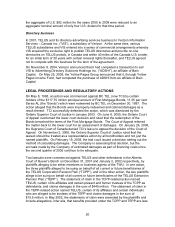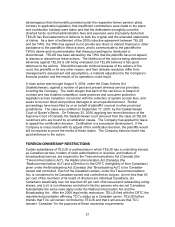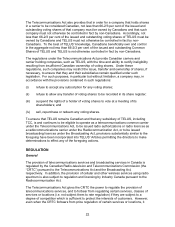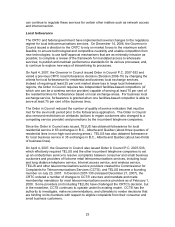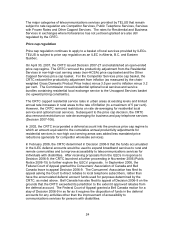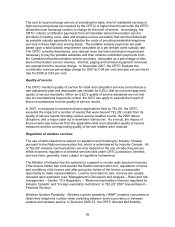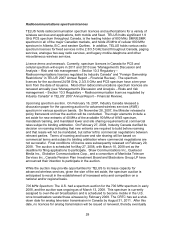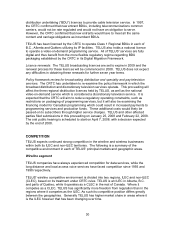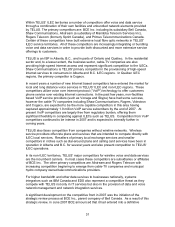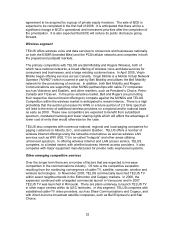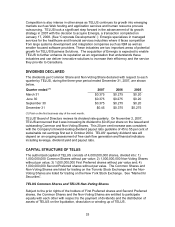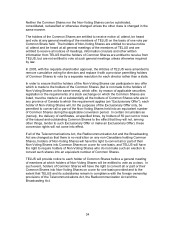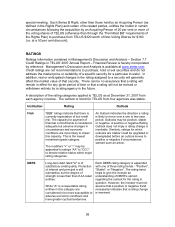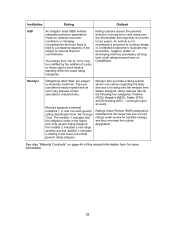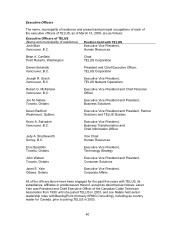Telus 2007 Annual Report Download - page 30
Download and view the complete annual report
Please find page 30 of the 2007 Telus annual report below. You can navigate through the pages in the report by either clicking on the pages listed below, or by using the keyword search tool below to find specific information within the annual report. 30
distribution undertaking (“BDU”) licences to provide cable television service. In 1997,
the CRTC confirmed that new entrant BDUs, including telecommunications common
carriers, would not be rate regulated and would not have an obligation to serve.
However, the CRTC confirmed that new entrants would have to meet all the same
content and carriage obligations as incumbent BDUs.
TELUS has been licenced by the CRTC to operate Class 1 Regional BDUs in each of
B.C., Alberta and Québec utilizing its IP facilities. TELUS also holds a national licence
to operate a video-on-demand programming service. All of TELUS’ services are fully
digital and thus benefit from the more flexible regulatory regime regarding BDU
packaging established by the CRTC in its Digital Migration Framework.
Licence renewals: The TELUS broadcasting licences are set to expire in 2009 and the
renewal process for these licences will be commenced in 2008. TELUS does not expect
any difficulties in obtaining these renewals for further seven year terms.
Policy framework review for broadcasting distribution and specialty and pay television
services: The CRTC has undertaken to re-examine the policy framework in which the
broadcast distribution and discretionary television services operate. This proceeding will
affect the three regional distribution licences held by TELUS, as well as the national
video-on-demand service which is considered a discretionary television service. It is
expected that the CRTC will aim to reduce regulatory operating constraints, such as
restrictions on packaging of programming services, but it will also be examining the
financing model for Canadian programming which could result in increased payments to
programming services and production funds. These additional costs would likely be
passed-on to subscribers through higher service charges. TELUS and other affected
parties filed submissions in this proceeding on January 25, 2008 and February 22, 2008.
The oral public hearing is scheduled to start on April 7, 2008, with a decision expected
by the end of 2008.
COMPETITION
TELUS expects continued strong competition in the wireline and wireless businesses
within both its ILEC and non-ILEC territories. The following is a summary of the
competitive environment in each of TELUS’ principal markets and geographic areas.
Wireline segment
TELUS companies have always experienced competition for data services, while the
long distance and local access voice services have faced competition since 1993 and
1998 respectively.
TELUS’ wireline competitive environment is divided into two regions, ILEC and non-ILEC
(CLEC), based on its treatment under CRTC rules. TELUS is an ILEC in Alberta, B.C.
and parts of Québec, while it operates as a CLEC in the rest of Canada. Where it
competes as a CLEC, TELUS has significantly more freedom from regulation than in the
regions where it competes as the ILEC. As such its competitive position differs greatly
between the geographies. Generally TELUS has higher market share in areas where it
is the ILEC however that has been changing over time.


